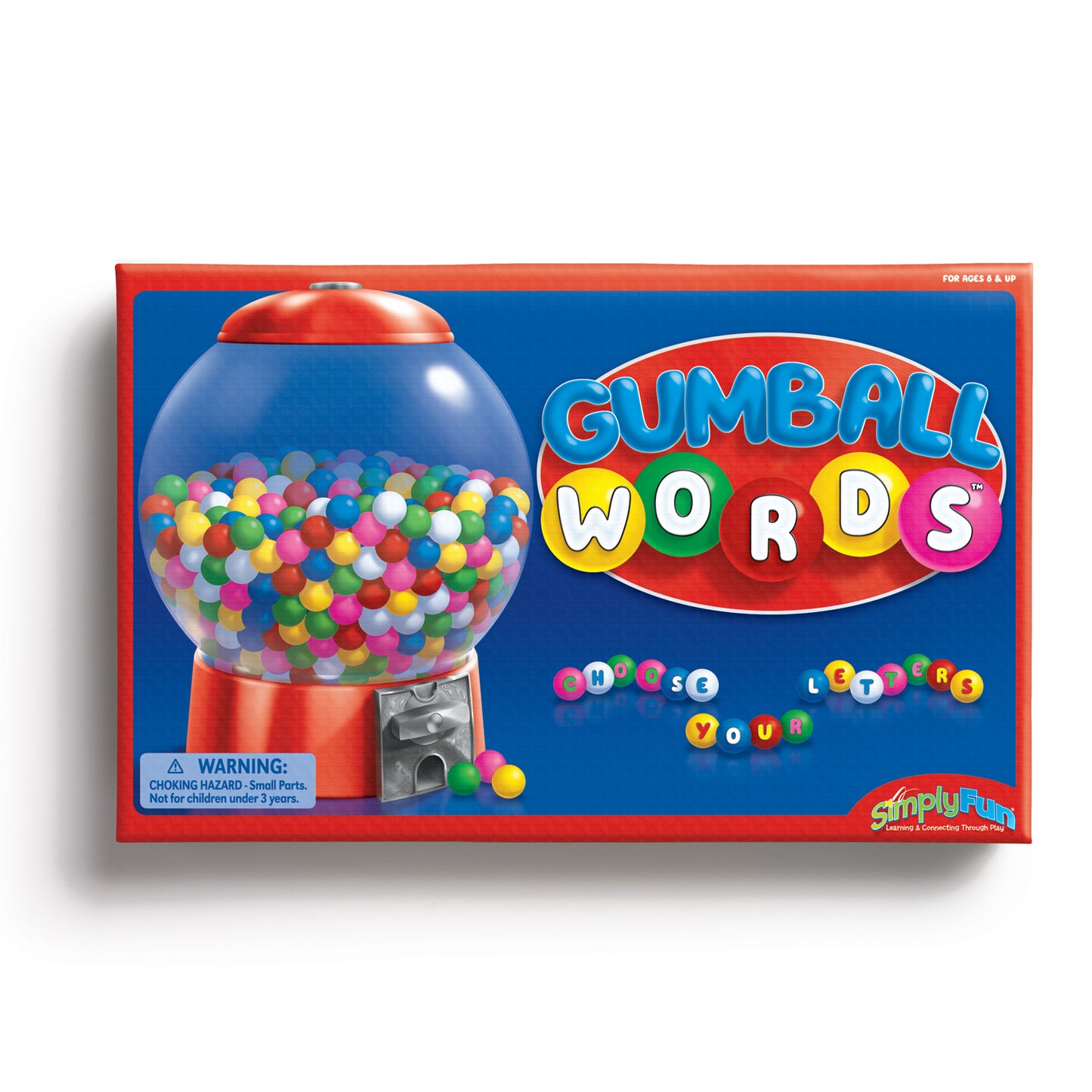
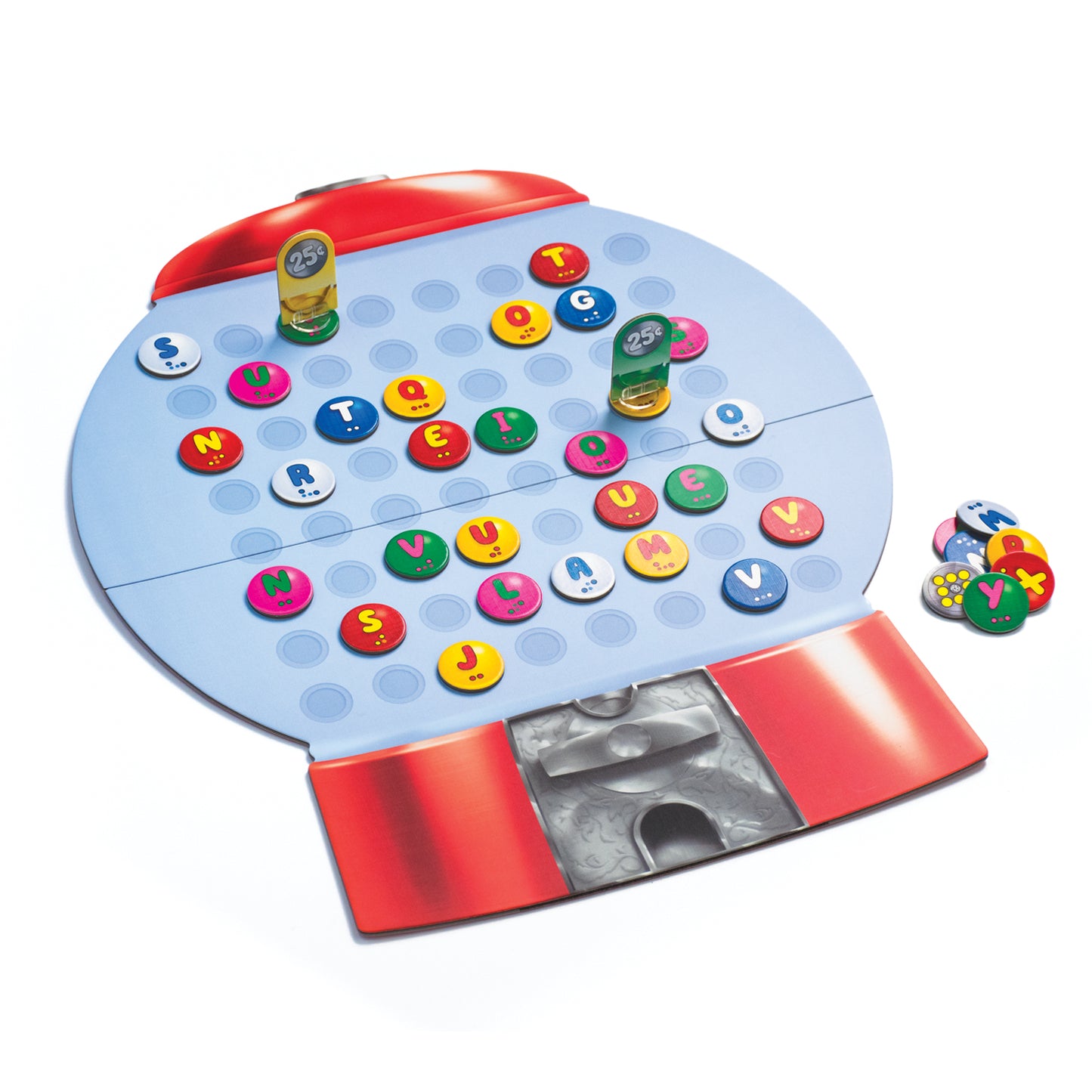
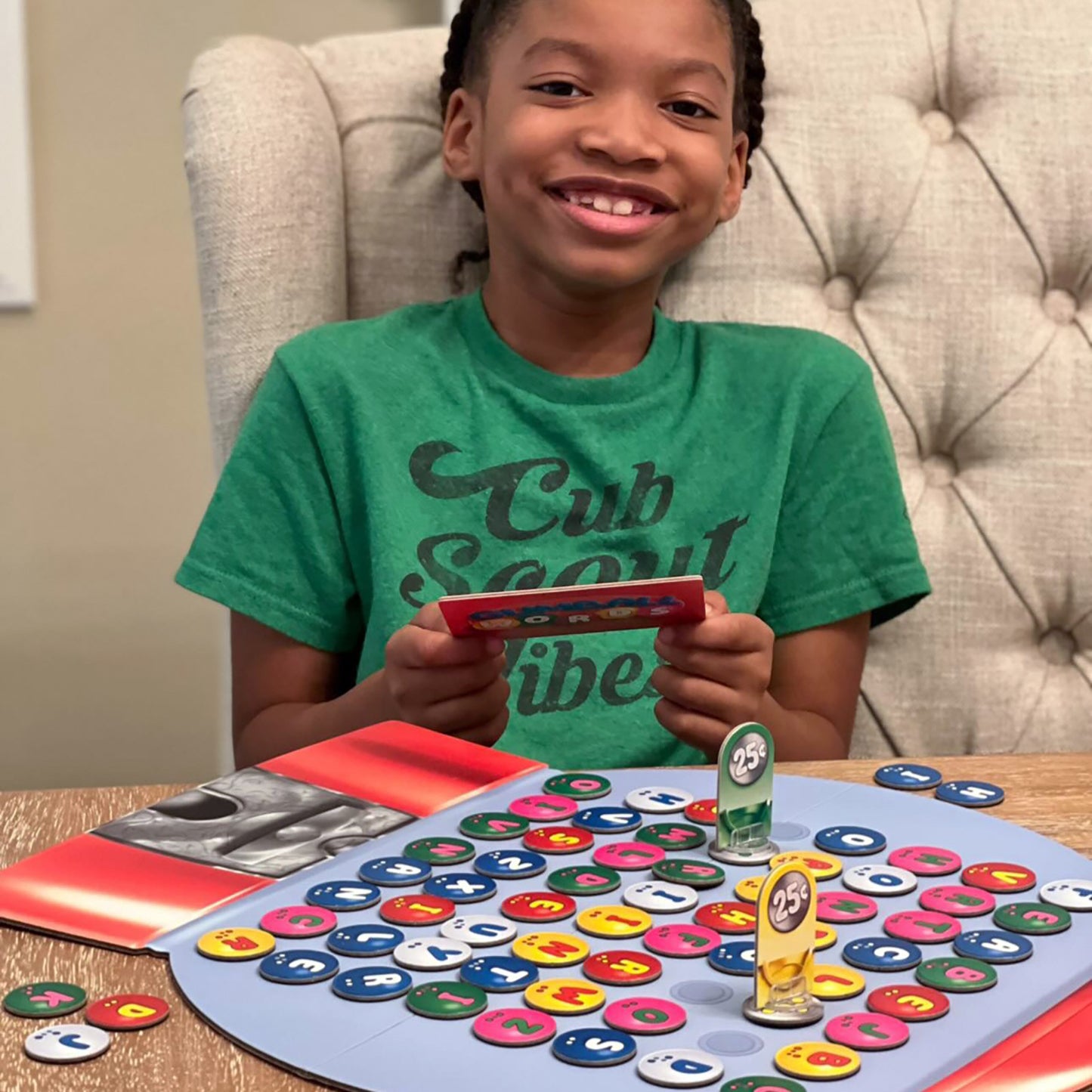
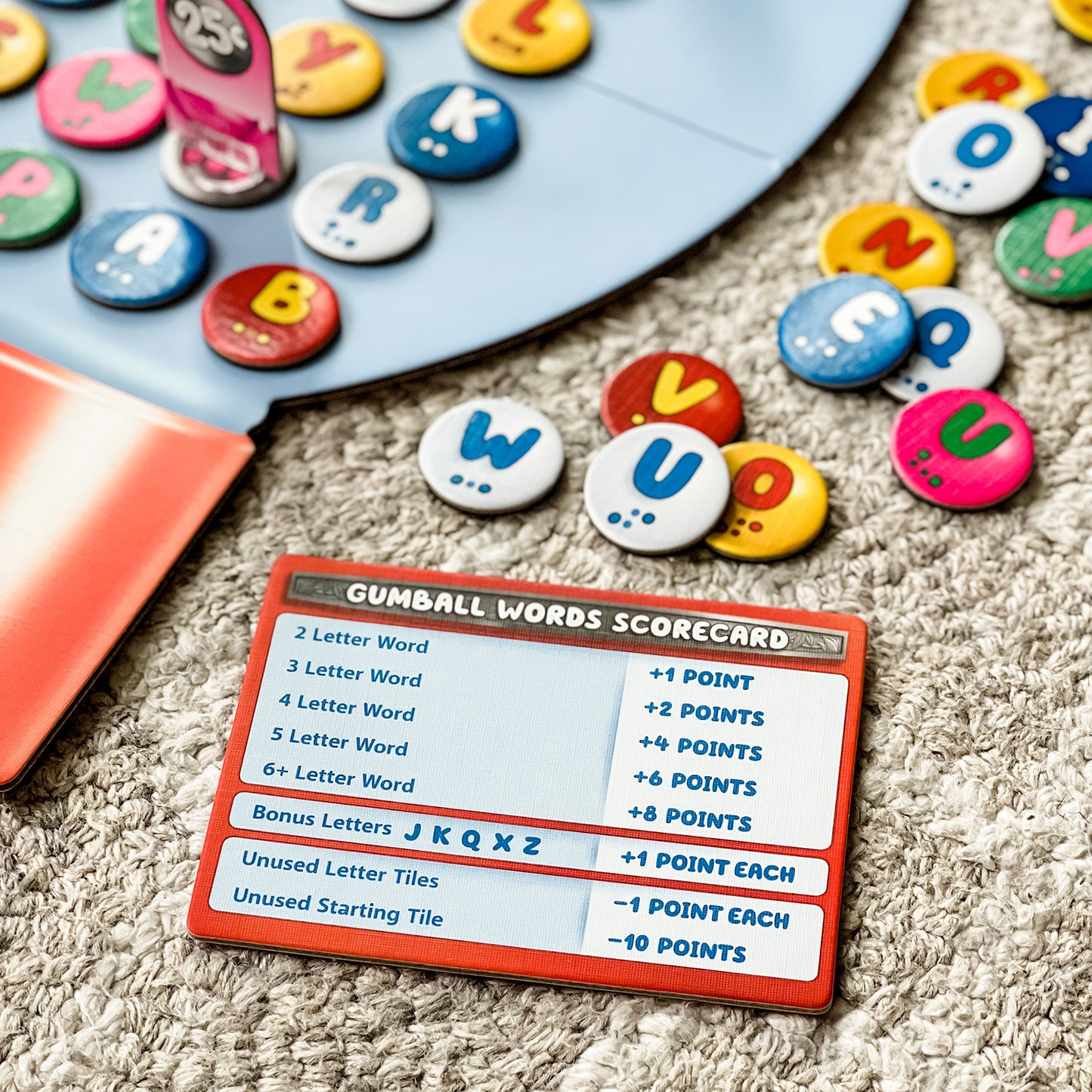
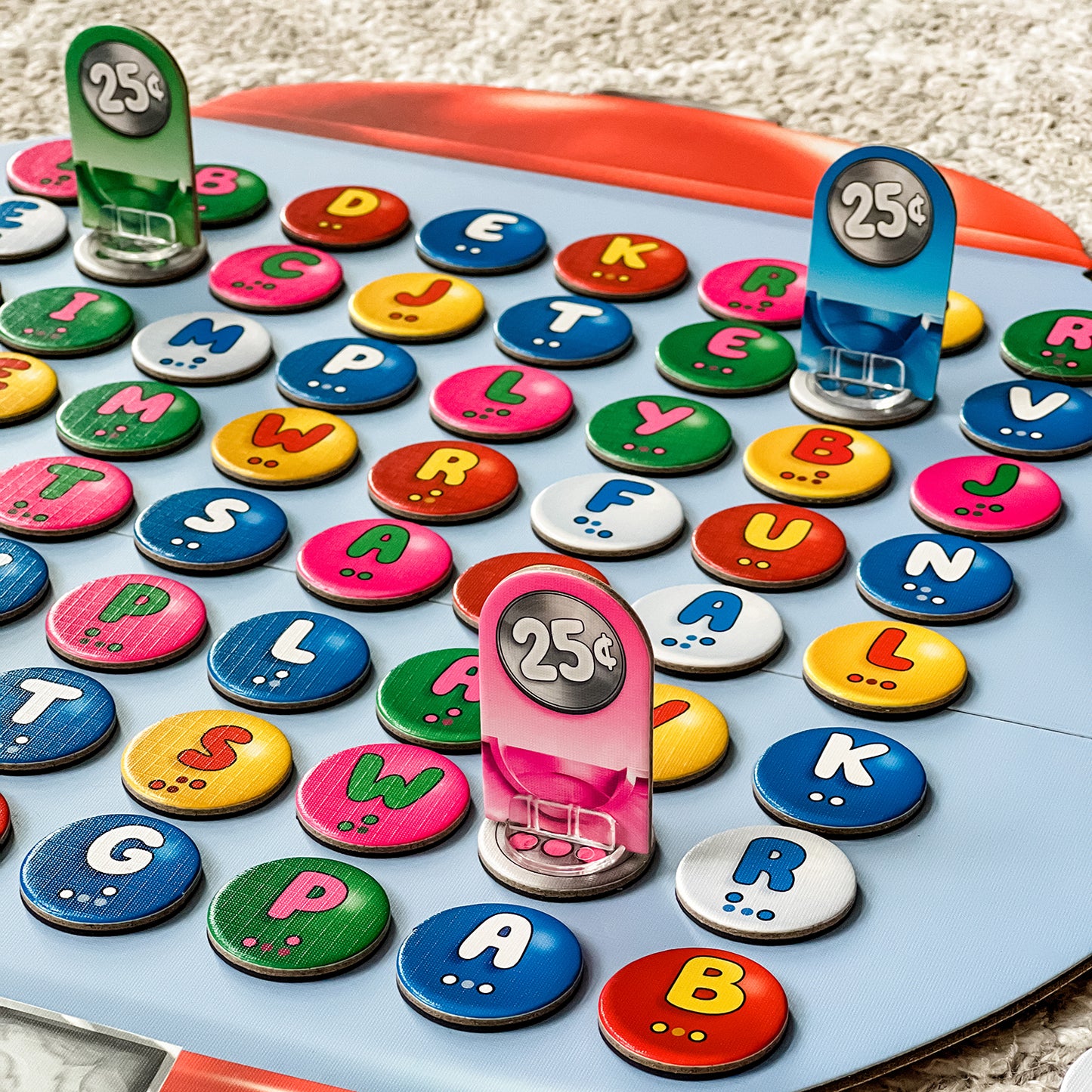
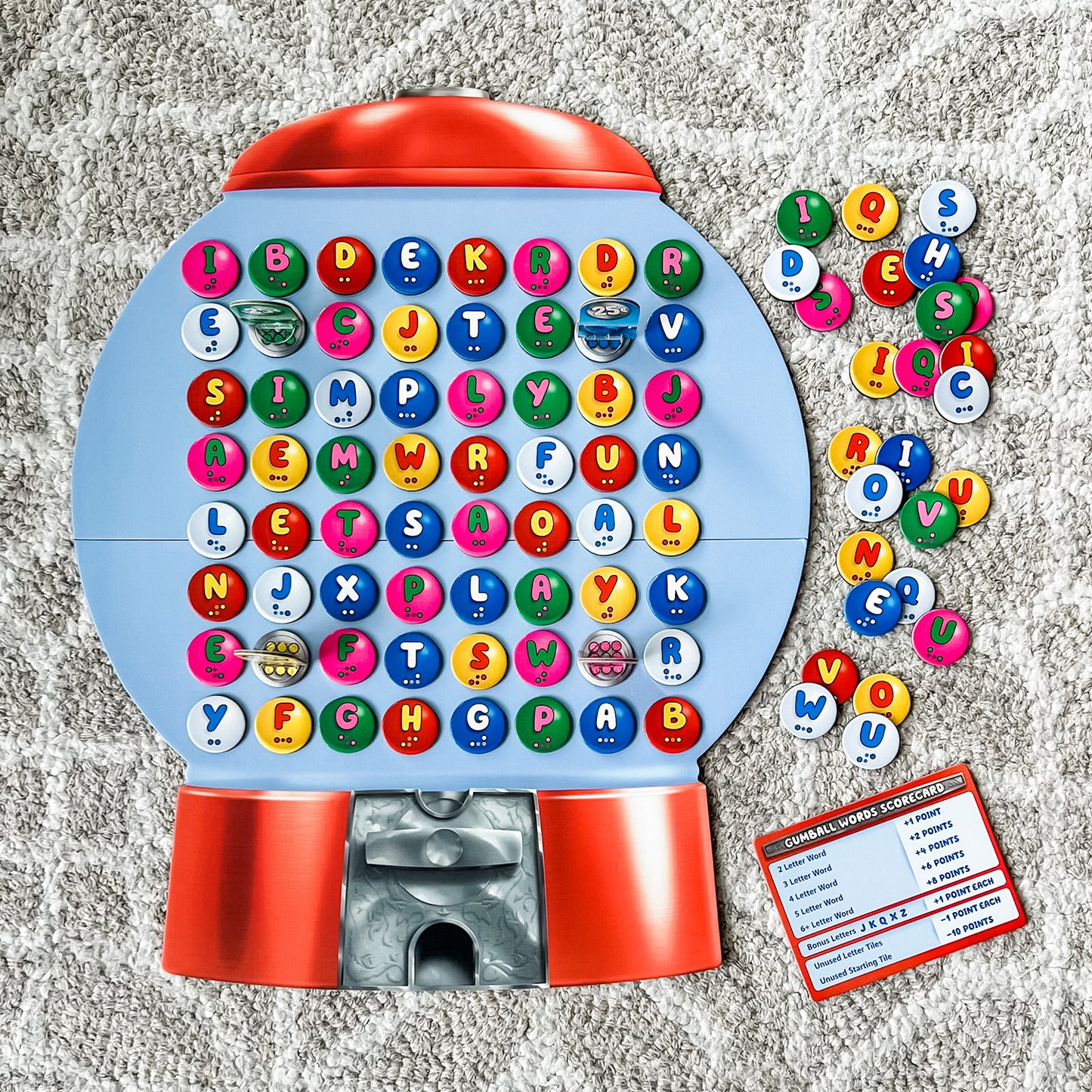
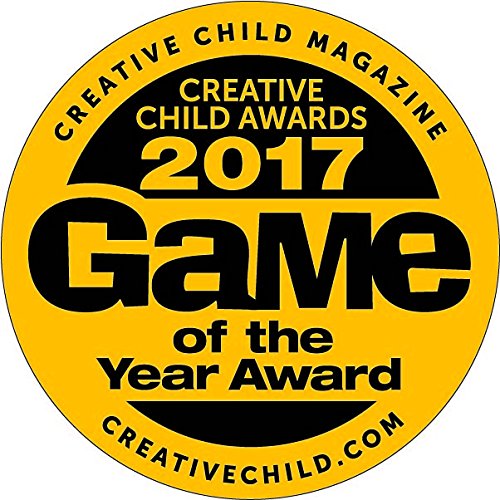

Collapsible content
In Gumball Words, Simply Fun’s newest strategy game, players move around the gumball machine gameboard by following the directions found on gumball letter tiles, and collect those tiles as they go. The player who uses those letter tiles to build the best words at the end of the game wins!
You can play Gumball Words with 2 to 4 players ages 8 and up.
Gumball Words helps players learn about spelling and vocabulary skills as they choose which letters they want to use when building words.
Gumball Words also helps players to learn strategy as they determine which pathways to travel, always trying to look at least two turns ahead, staying in the game for as long as possible.
To set up Gumball Words, first place the gameboard in the center of the play area. The board should lay flat when unfolded.
Remove the scorecard from the box and place it next to the gameboard in view of all players. This scorecard shows players how to score their words at the end of the game.
Give each player a coin pawn and a matching color starting tile. Each player should place their starting tile onto the gameboard one space diagonally away from one of the corners. Each player’s coin pawn should then be placed on top of their starting tile.
Now, randomly fill each space on the gameboard with letter tiles from the box until all 64 spaces are filled. As an example, if there are 4 players, then you will be placing 60 letter tiles on the gameboard; for a 2-player game, 62 tiles. The gameboard and letter tiles are magnetic, so they should stay in place. Once the gameboard is filled, all the remaining letter tiles are left in the box.
The object of Gumball Words is to stay in the game as long as possible, collecting as many letter tiles as you can to build words and score the most points. If you run out of movement options, then you must remove your pawn from the gameboard, so be strategic when choosing what path to take! The player who can build the highest-scoring words at the end of the game wins!
On each player’s first turn, you may choose to move your coin pawn from the starting tile to any letter tile that is one space away in any direction, including diagonally. This action is depicted on the starting tiles; the coin in the center, surrounded by open spaces to choose from.
After this first turn, each player must follow the movement instructions found on the bottom of each letter tile. Every turn you will use the movement instructions found on the letter tiles to determine where you can go to next. The movement instructions are found below the letter on each tile, and there are seven different possible moves:
The two dots mean that your coin pawn can move to any of the letter tiles that are right next to you, meaning one space up, down, left or right. Players may not move diagonally for this movement type.
The three side-by-side dots allow your player pawn to move two spaces over in any direction.
Note: Notice both outside dots are outlined in black, which throughout the game denotes the starting and stopping places allowed on each set of movement instructions. The smaller, inside dots represent the spaces your coin pawn will travel through.
The three dots that form a triangle allow your coin pawn to move one space over, and then one space up or down. The result is that your coin pawn may move diagonally one space in any direction.
The next two movement types may look very similar, but they are opposites and will direct your coin pawn to different end locations. Keep in mind that you may start these movement instructions by going in any of the 4 directions you want (up, down, left or right), but once your initial direction is determined you must follow the movement instructions exactly:
This movement instructs your coin pawn to move forward one space, then move right one space, and then move left one space.
This movement instructs your coin pawn to move forward one space, then move left one space, and then move right one space.
The next two movement types are like the previous two in that they are opposites of one another and will direct your pawn to different end locations:
This movement type directs you to either move your pawn forward two spaces and then move right one space, or to move your pawn down one space and then move left two spaces.
This movement type directs you to either move your pawn forward two spaces and then move left one space, or to move your pawn down one space and then move right two spaces.
Following the movement instructions, each player moves once per turn. Every time you move off a letter tile, you pick up that letter tile and place it in front of you. So, the destination tile on one turn becomes the tile that determines your movement during the next turn.
By looking at where you are located on the gameboard and what letter tiles are around you, players can start to chart a pathway that allows them to build the best words possible, and can see where empty spaces on the gameboard may hinder their ability to continue.
The player who most recently saw a gumball machine goes first. Remember that your movement is determined by your starting tile on your first turn.
At the start of each turn, look at the tile your coin pawn is on and follow the movement instructions to decide where to move to next. Keep in mind that only one coin pawn can be on a letter tile at the same time.
After you move, collect the tile that your pawn started from and place it in front of you. Your turn is now over and it is the next player’s turn.
Players keep taking turns as long as they can move to a new letter tile. If you are unable to move to a letter tile, then you may not take any more turns. This is why it is important to look as far ahead as possible. Collect your coin pawn and the letter tile that it is currently standing on and place them in front of you. The remaining players may continue taking turns and earning letter tiles until they are unable to move to a new letter tile.
Once you have removed your coin pawn from the gameboard, start to use all the letter tiles that you have collected to build words and score points. Players should refer to the scorecard to help them build the highest-scoring words possible.
Words must contain at least two letters. No single-letter words are allowed.
Words may be overlapped to share letters, or spelled separately so that they are not touching.
Words may only be spelled vertically or horizontally.
Any letter tiles that are next to each other must spell a word.
Letters must be used correctly. The movement instructions are always below the letter, so an ‘M’ cannot be used as a ‘W’.
The starting tile is wild and can count for any letter. If the starting tile is used to spell two different words, it must be the same letter in both words.
No proper names, abbreviations, acronyms, conjunctions, or words that require a space or hyphen are allowed.
Try your best to use all your letter tiles and your starting tile. Deduct one point for each letter tile that you do not use, and deduct ten points if you do not use your starting tile.
Once you have created the highest value words that you can, use the scorecard to total your points, and deduct points for any unused tiles.
The player with the most points wins. In case of a tie, each player tells a story using all of their words. The player with the best story wins.


Core Standard*: Language
- Language
- Vocabulary Acquisition and Use. Grade Levels 3rd, 4th
- Math
- Generate and analyze patterns: Grade Level 4th
- Operations and Algebric Thinking


Explore
What Does Child Do To Use Skill In The Game?
Players needs to look at various spots on the board looking for viable places to move their Coin Pawn. More advanced players will also look one or two moves ahead, as in chess or checkers.
How Parents Can Assist Learning
When first learning, encourage children to just focus on collecting letters rather than planning further moves ahead.
To help children visualize their options, suggest that they rotate letter tiles 90° at a time. This'll help them more easily determine where they're pawn can be moved.
During the scoring phase, remind children that they can repeatedly move letters around in any arrangement to make the most words and use as many of their letters as possible.
Learning Implications and Educator Support
Gumball Words is very good for developing spatial reasoning and spelling skills.
When first learning, encourage children to just focus on collecting letters rather than planning further moves ahead.
To help children visualize their options, suggest that they rotate letter tiles 90° at a time. This'll help them more easily determine where they're pawn can be moved.
During the scoring phase, remind children that they can repeatedly move letters around in any arrangement to make the most words and use as many of their letters as possible.
Determine
What Does Child Do To Use Skill In The Game?
Players decide where to move their Coin Pawn, which letters they want to obtain and which moves they may be able to make on their next turn.
Additionally, they will create the highest scoring words possible with the letters they have picked up during the game.
How Parents Can Assist Learning
When first learning, encourage children to just focus on collecting letters rather than planning further moves ahead.
To help children visualize their options, suggest that they rotate letter tiles 90° at a time. This'll help them more easily determine where they're pawn can be moved.
During the scoring phase, remind children that they can repeatedly move letters around in any arrangement to make the most words and use as many of their letters as possible.
Learning Implications and Educator Support
Gumball Words is very good for developing spatial reasoning and spelling skills.
When first learning, encourage children to just focus on collecting letters rather than planning further moves ahead.
To help children visualize their options, suggest that they rotate letter tiles 90° at a time. This'll help them more easily determine where they're pawn can be moved.
During the scoring phase, remind children that they can repeatedly move letters around in any arrangement to make the most words and use as many of their letters as possible.
Compare
What Does Child Do To Use Skill In The Game?
Players will examine each of the four different spaces they can move their Coin Pawn to determine which is the best choice.
Additionally, they will compare different letter combinations to make the highest scoring words.
How Parents Can Assist Learning
To help children visualize their options, suggest that they rotate letter tiles 90° at a time. This'll help them more easily determine where they're pawn can be moved.
As children become more skilled at the game, encourage them to look ahead at least one move to help make the best choice of where to move their pawn.
During the scoring phase, remind children that they can repeatedly move letters around in any arrangement to make the most words and use as many of their letters as possible.
Learning Implications and Educator Support
Gumball Words has numerous implicit levels of mastery in strategy and spatial reasoning. The more children play, the more skilled they will be at comparing options and planning one or two moves ahead.
To help children visualize their options, suggest that they rotate letter tiles 90° at a time. This'll help them more easily determine where they're pawn can be moved.
As children become more skilled at the game, encourage them to look ahead at least one move to help make the best choice of where to move their pawn.
During the scoring phase, remind children that they can repeatedly move letters around in any arrangement to make the most words and use as many of their letters as possible.
Plan
What Does Child Do To Use Skill In The Game?
Players will try to plan where to move their Coin Pawn, which letters they want to obtain and which moves they may be able to make on their next turn.
How Parents Can Assist Learning
To help children visualize their options, suggest that they rotate letter tiles 90° at a time. This'll help them more easily determine where they're pawn can be moved.
As children become more skilled at the game, encourage them to look ahead at least one move to help make the best choice of where to move their pawn.
Learning Implications and Educator Support
Gumball Words has numerous implicit levels of mastery in strategy and spatial reasoning. The more children play, the more skilled they will be at comparing options and planning one or two moves ahead.
To help children visualize their options, suggest that they rotate letter tiles 90° at a time. This'll help them more easily determine where they're pawn can be moved.
As children become more skilled at the game, encourage them to look ahead at least one move to help make the best choice of where to move their pawn.
If you notice that a child is collecting too many vowels or consonants, suggest the they seek out other letters that will be helpful in creating words at the end of the game.
Practice
What Does Child Do To Use Skill In The Game?
Gumball Words provides players with great opportunity to practice spelling and word formation.
How Parents Can Assist Learning
No special adult support required.
Learning Implications and Educator Support
To teach specific words, educators may set up the board with all the required letters. Then give the players words that they are hunting for. The player who spells the more words from the list wins the game, or play the game collaboratively to see if the children can work together to collect all the needed letters.
Solve
What Does Child Do To Use Skill In The Game?
The game board is constantly changing as players pick up Letter Tiles and place their Coin Pawn on other tiles.
How Parents Can Assist Learning
As the game is being learned, children may place their pawn in non-strategic ways, e.g. in a way where they cannot move the pawn on their next turn, or they may not spell all the words they are capable of. If you see this, ask the child to explain their thinking and discuss what they might do differently next time.
After children have mastered the basics of the game, they learn new information constantly during game play. This information directly effects how children strategize an approach for playing their pawn, collecting Letter tiles and ultimately solving the game.
Additionally, this ability to shift strategies based on new information can help children cope with the stresses of change in other areas of their life.
Learning Implications and Educator Support
Gumball Words involves uses of visual spatial problem solving, directionality and if/then problem solving.
After children have mastered the basics of the game, they learn new information constantly during game play. This information directly effects how children strategize an approach for playing their pawn, collecting Letter tiles and ultimately solving the game.
Demonstrate
What Does Child Do To Use Skill In The Game?
Players build demonstration skills as they show their words and score for those words to other players.
How Parents Can Assist Learning
No special adult support required.
Learning Implications and Educator Support
No special adult support required.
Create
What Does Child Do To Use Skill In The Game?
While spelling is not creative, building grids of words and word combinations to maximize scoring is a creative skill building part of Gumball Words.
How Parents Can Assist Learning
During the scoring phase, remind children that they can repeatedly move letters around in any arrangement to make the most words and use as many of their letters as possible.
Learning Implications and Educator Support
During the scoring phase, remind children that they can repeatedly move letters around in any arrangement to make the most words and use as many of their letters as possible.
*Data compiled from CCSSI ELA Standards, WA Science Standards, and Washington Social Studies Standards


Cognitive
Suggestions for How to Modify Play Experience
Gumball Words requires a high degree of spatial reasoning, both for moving the tokens and for making connected words. When first learning the game, have all players create individual words, rather than connected words ala a crossword puzzle. This will be easier for the child with cognitive delays and make the scoring more equitable. Additionally, help the child by making part of a word for them and see if they can add a letter to make it a word. Note that the beginning letter is easiest to find.
Play the game with a partner. This will allow someone to help the child with cognitive delays interpret the directional dots on the letter tiles. The partner can also help with word formation at the end of the game. Encourage the partner to involve the child in forming a word by making a word minus one letter and seeing if the child add a letter or can find a place to put the word on the letter grid.
High frequency letters include e, t, a, i, n, o, s, h, r, d, l, c. Encourage children with cognitive delays to find these letters as they will be able to formulate more simple words.
Communication
Suggestions for How to Modify Play Experience
Practice phonological awareness by sounding out the letters as they are picked up, and then sounding out and spelling the words that are made at the end of the game.
Remind children to find both vowels and consonants. Children with reading difficulties will benefit from knowing frequently used letters. High frequency letters include e, t, a, i, n, o, s, h, r, d, l, c. Write these on a piece of paper to give the child a little help in playing the game.
Sensorimotor
Suggestions for How to Modify Play Experience
The letter tiles are magnetic, so this helps players avoid accidentally moving the pieces. Manipulating the letters to make words may be challenging. If needed, children can say the word they want to make and let another player place the letters where the children indicate they should go.
If the child has severe challenges with fine motor movements, Gumball Words may be too challenging.
Social Emotional/Behavioral
Suggestions for How to Modify Play Experience
Play with a partner to make the game collaborative. This will teach children to negotiate and discuss options before making a quick judgement.
Gumball Words requires attention to details and patience to study options. Remind players to take their turns in steps: 1) Look at the directional dots on the bottom of the letter tile where their token is located, 2) analyze the options in a pattern (Where will I land if I go left, right, up, or down), 3) which direction lands me on a letter I want or need? Having a systematic way to think can help children who are impulsive or easily frustrated.
Vision
Suggestions for How to Modify Play Experience
Children with low vision will have difficulty with the complexity of the board and seeing the small directional dots at the bottom of the letter tiles. For this reason Gumball Words is not recommended for children with low vision.
Hearing
Suggestions for How to Modify Play Experience
Children with hearing concerns should be able to play Gumball Words.
*Data compiled from CCSSI ELA Standards, WA Science Standards, and Washington Social Studies Standards


Autism Strengths & Interests
Short Summary of Strengths & Interests
- Spatial reasoning
- Spelling & Vocabulary
- Creativity
Is good at matching visual items
This game is not appropriate
Has a good memory for sensory details, including visual, touch, taste and smell
This game is not appropriate
Has a good memory for words, phrases and dialouge
Is This Game Appropriate? Yes
Description
Creating words is a major focus of Gumball Words. Players who have a large vocabulary and good spelling will do well with the game. Children with autism often have a good memory for phrases and dialogue they have heard, so they may do well if they can generate these words. Other players can help with spelling if needed.
Has a good memory for pictures, numbers and patterns
Is This Game Appropriate? Yes
Description
Players need to understand the meaning of the "dot map" pattern on each letter tile. A good memory for patterns will help the child interpret their options for movement on the board. Additionally, the instructions give clear visual guide for how to interpret the "dot map".
Likes to put things in order or a sequence
Is This Game Appropriate? Yes
Description
Players have to move around the board to obtain the letters they want. This means they need to be able to sequence several turns to get to a desired letter (e.g. a vowel). In addition to sequencing plays on the board, players need to sequence letters to make words in the final phase of the game. Players who are good at both spatial sequencing and letter sequencing to make words will do well with Gumball Words.
Learns through visualizing or "replaying" actions in their mind
Is This Game Appropriate? Yes
Description
Players need to be able to mentally rotate the "dot map" on each letter in their minds to be able to see where optional moves would place them. Ability to mentally replay actions is a good way to learn this strategy, as players will remember how each pattern can be rotated. In addition, ability to replay actions is valuable for spelling as players remember patterns in words and exchange letters to make new words.
Likes activities with rules, such as math and phonics
Is This Game Appropriate? Yes
Description
Knowledge of phonics and spelling rules will be a great benefit to players in the spelling portion of the game, as it will enable them to create many options with base words or word segments.
Is very concrete and literal
This game is not appropriate
Learns in small "chunks" (for example, phone numbers are 3 chunks of number xxx-xxx-xxxx that are combined together)
Is This Game Appropriate? Yes
Description
Players who have knowledge of prefixes, suffixes, compound words and word families will do well with the word creation part of the game. Knowing these small chunks of words enables players to make a wider variety of words, as they can take one chunk and add letters to make a new word.
Is good at nonverbal reasoning and logic
Is This Game Appropriate? Yes
Description
Nonverbal reasoning is required for the board portion of the game. Players need to be able to think about which letters they can access by following the movement instructions on the "dot maps" on each letter. This reasoning will guide their moves to desired letters.
Likes spatial problem solving
Is This Game Appropriate? Yes
Description
The first part of Gumball Words is all about spatial problem solving. Players need to be able to think about which letters they can access by following the movement instructions on the "dot maps" on each letter. They can then choose a direction to move following that pattern.
Can read well with good vocabulary, though may not fully comprehend content
This game is not appropriate
Likes to use and has good fine motor skill
Is This Game Appropriate? Yes
Description
Fine motor skills are needed to move the token to different letters on the board. Players also need to be able to arrange the letter tiles into words in the last phase of the game.
Likes established routines or set ways of doing things
Is This Game Appropriate? No
Description
Although the game is played in the same sequence every time, there is a great variation in results from game to game.
Likes manipulating, constructing or building things
This game is not appropriate
Likes to use and has good musical abilities
This game is not appropriate
Likes to use and has good drawing skills
This game is not appropriate
Autism Special Considerations
Appears to ignore other's communication and/or has difficulty giving eye contact to a communication partner
Is This Game Appropriate for Child with Characteristic? Yes
Can Child with Characteristic Play Game w/o Modification? Yes
Strategies for Developing Compensatory Skills:
Gumball Words can be played without giving eye contact or communicating to the other players. Players can focus on the board for their moves and later to the letters they have gathered to make their word grids.
Has difficulty understanding complex verbal directions
Is This Game Appropriate for Child with Characteristic? No
Can Child with Characteristic Play Game w/o Modification? No
Strategies for Developing Compensatory Skills:
The players in Gumball Words need to know alphabet letters, directional dot symbols indicating which way to move, and how to form interconnecting word patterns. The directions may be too complex for some children with autism, as the players need to understand how to move a token to get desired letters to make words and how to later form interconnecting words. If children do not have good visual spatial understanding as well as spelling ability, Gumball Words may not be a good match.
Uses vocabulary inaccurately or demonstrates echolalia (repeating another's speech)
Is This Game Appropriate for Child with Characteristic? Yes
Can Child with Characteristic Play Game w/o Modification? Yes
Strategies for Developing Compensatory Skills:
If echolalia or extraneous talking is not excessive, it should not interfere with playing Gumball Words.
Gets stuck repeating a verbal topic or physical actions and/or has difficulty attending to others' actions or topic.
Is This Game Appropriate for Child with Characteristic? Yes
Can Child with Characteristic Play Game w/o Modification? No
Strategies for Developing Compensatory Skills:
If the child with autism has repetitive actions, encourage the child to manipulate their letters between turns to make a variety of words. This will keep the hands busy and will help in the last part of the game when interconnected words are formed.
Has difficulty producing speech/communication
Is This Game Appropriate for Child with Characteristic? Yes
Can Child with Characteristic Play Game w/o Modification? Yes
Strategies for Developing Compensatory Skills:
Children do not need to communicate to play the game, but should be encouraged to name the letters they pick up, spell and label the words they make, and count their points.
Has difficulty sequencing multi-step actions and/or doing complex abstract tasks
Is This Game Appropriate for Child with Characteristic? No
Can Child with Characteristic Play Game w/o Modification? No
Strategies for Developing Compensatory Skills:
The players in Gumball Words need to know alphabet letters, directional dot symbols indicating which way to move, and how to form interconnecting word patterns. The multiple steps in the game may be too complex for some children with autism, as the players need to understand how to move a token to get desired letters to make words and how to later form interconnecting words. If children do not have good visual spatial understanding as well as spelling ability, Gumball Words may not be a good match.
Demonstrates difficulty initiating and maintaining social interactions
Is This Game Appropriate for Child with Characteristic? Yes
Can Child with Characteristic Play Game w/o Modification? Yes
Strategies for Developing Compensatory Skills:
Gumball Words can be played without social interactions beyond turn-taking. Encourage commenting on others' plays and the words they build at the end of the game.
Acts out or demonstrates avoidance behaviors when frustrated, overwhelmed, or needs more sensory input.
Is This Game Appropriate for Child with Characteristic? Yes
Can Child with Characteristic Play Game w/o Modification? No
Strategies for Developing Compensatory Skills:
The players in Gumball Words need to know alphabet letters, directional dot symbols indicating which way to move, and how to form interconnecting word patterns. All of these aspects combined may be frustrating for children who have difficulty with one or more of these tasks. Break down the game before playing. First, have the child identify different letters. Second, practice following the dots as you move from one disk to another. Third practice making words with random letters. Once the child feels comfortable with these steps, play with just two players. Then move to more players. If this is too overwhelming, then play Gumball Words with a partner. If this sounds too stressful for the child, Gumball Words is not a good match.
Has short attention span for non-preferred activities
Is This Game Appropriate for Child with Characteristic? No
Can Child with Characteristic Play Game w/o Modification? No
Strategies for Developing Compensatory Skills:
Reading directional cues and forming words are the two main tasks in Gumball Words. If those are not preferred activities, the game may not be a good match.
Needs sameness or consistent routines and/or has difficulty with transitions from one activity to another
Is This Game Appropriate for Child with Characteristic? Yes
Can Child with Characteristic Play Game w/o Modification? No
Strategies for Developing Compensatory Skills:
Because there are two very different skills involved in Gumball Words, children with autism may have difficulty shifting from one task to another. Break down the game before playing. First, have the child identify different letters. Second, practice following the dots as you move from one disk to another. Third practice making words with random letters. Once the child feels comfortable with these steps, play with just two players. Then move to more players. If this is too overwhelming, then play Gumball Words with a partner. If this sounds too stressful for the child, Gumball Words is not a good match.
Has difficulty understanding others' feelings, intentions, and the reasons for others' actions.
Is This Game Appropriate for Child with Characteristic? Yes
Can Child with Characteristic Play Game w/o Modification? Yes
Strategies for Developing Compensatory Skills:
Children can play Gumball Words without understanding what other players are thinking and feeling.
*Data compiled from CCSSI ELA Standards, WA Science Standards, and Washington Social Studies Standards


Extra Ways to Play the Game
Modify Gumball Words by adding an element of chance. During the board part of the game players carefully make moves to get the letters they want on the board. Before they start making their words, have each player contribute two letters to a pile, mix them up, and then draw two back.
Materials Needed
No additional materials needed.
Developmental Benefits
This expansion allows players to get rid of potentially redundant or letters that are difficult to use and potentially gain letters enabling them to make new words. Of course, they may end up with their own letters again too!
Extra Ways to Play the Game
Place starting tiles in the corners. If a player moves to this tile, they can then move to any other corner of the board.
Materials Needed
No additional materials needed.
Developmental Benefits
Normally, each turn allows a player to move across 2 to 4 spaces on the board. This expansion allows player to be able to access another part of the board without having to move there space-by-space. It adds an additional element of spatial reasoning and strategic planning.
Extra Ways to Play the Game
Try playing Gumball Words without the board. Instead, layout all of the tiles in a 10x12 grid. Play the game according to the rules.
Materials Needed
No additional materials needed.
Developmental Benefits
This expansion increases the options for planning and strategizing a sequence of moves.
*Data compiled from CCSSI ELA Standards, WA Science Standards, and Washington Social Studies Standards
- Choosing a selection results in a full page refresh.
- Opens in a new window.









